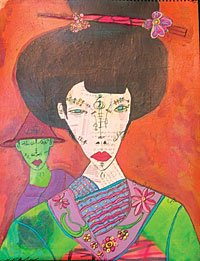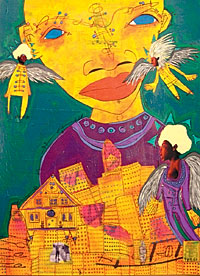
“Place Your Illogical Hand,” by Gabriel Shaffer
|
Gabriel Shaffer isn’t cranking out serene watercolors, cuddly critters or rosy-hued commissioned portraits. Still, do Close Encounters-style faces and gangly, disproportionate limbs a rebellious folk artist make? Not quite.
Bold assertions in his artist’s statement to the contrary, “I don’t consider myself an outsider artist,” Shaffer recently confessed to Xpress.
“But I’ve been influenced by it all my life.”
A definition culled from Princeton University’s Web site sets strict parameters around the habitually stretched title, calling outsider art “a genre of art and outdoor constructions made by untrained artists who do not recognize themselves as artists.” Think of the endlessly imitated Rev. Howard Finster, who was divinely inspired to decorate his rural Georgia property with roughhewn sculptures and paintings of a Biblical nature. Or contemporary artist Charles Benefiel, who suffers from severe obsessive-compulsive disorder compelling him to produce complexly stippled works.
Famous posthumously, Finster never sought to move his sculptures beyond his Paradise Gardens. Benefiel has gained some notoriety, albeit from the psychiatry profession, after suffering a nervous breakdown.
“Those types of labels only apply when you’re talking to folks about anything other than art,” muses Shaffer, who is young, healthy, sane and — by his own account — well-traveled, well-connected, oft-viewed and even collected by an international clientele.
Local art buffs can catch Shaffer’s work at Artemisia Gallery through the end of the month. But the painter is quick to admit his style is one of experimentation and change. His current approach, he says, is “only about eight months old.” And as the artist expands, so, it seems, does the umbrella sheltering outsider artists from their original requirements.
God bless the child

“As the Flock Flies in Circles,” by Gabriel Shaffer
|
So you can’t call his stuff folk, intuitive, marginalized, naive, visionary, or any other purely outsider designation. And yet Shaffer’s work, being strangely accessible, manages undeniable appeal.
His show at Artemisia, titled Son of Halvetia, takes its name from a photo Shaffer’s artist mother Cher presented him on his recent birthday. In the picture, young Gabriel stands in front his mother’s painting “Halvetia.” “It’s [that painting] that started her career,” Shaffer explains by phone from his River District studio.
Beyond the name, though, don’t expect many similarities between mother and son. Where Cher’s self-taught folk pieces speak of Grandma Moses-style Appalachian scenes, farm animals and figures, Gabriel’s work is galaxies apart. They’re portraits of a sort, many done on a large scale, and each face rendered in acrid colors (poisonous greens, bruised purples) and dissected into road maps with a series of marker-drawn squiggles and arrows (not so different from the anti-wrinkle lines that squirm over Andie MacDowell’s visage in the L’Oreal commercial).
“All these pieces of people’s lives that they didn’t realize they’d left behind are now being woven into collages,” the artist explains of the layered concepts and implied stories crafted into each painting.
“I’ve only been painting on a full-time basis for about four-and-a-half years. I’ve mainly focused on short-story writing and poetry, so storytelling has been my thing.”
One man’s geisha
What works best are Shaffer’s Japanese-inspired images — geishas and warriors — especially in the comic-book reminiscent “Of the Shining Genji.” The red, purple and green palette steps away from the natural world while nodding to the cultural invasion of Japanime.
“A geisha, to an extent, is an enslaved form of beauty — which, to an extent, is what art is,” Shaffer offers sagely.
He also humbly imparts, “All my life, I’ve been a comic-book geek.”
Hand-drawn graffiti erupts from knife layers of acrylic paint. A graffitied third eye shines from the lime green, pupil-less face on “Cistine San Pedro.” This startling street image alters the language of the religious iconography, changing the halo rays over the figure’s head into angry liberty spikes.
What doesn’t work as well is a rather derivative series of paper-and-paint collaged pieces using shiny images, culled from the pages of National Geographic, that compete with Shaffer’s own creations. The overly real figures dance distractingly around their painted, green-faced and luminous-eyed companions like multiple personalities brought to life. The metaphorical good voice and bad voice are seated on the figures’ opposing shoulders — only in Shaffer’s case, it’s miniature teams of African dancers and Indian milkmaids.
The show, overall, is reminiscent of the ethereal Griffin and Sabine images from the adult picture-book series, or the compelling-yet-creepy kids and animal stationery of Yoshitomo Nara. Only Shaffer manages a more spiritual (and simultaneously grittier) brand of otherworldliness. Exposing his urbanite soul, this pop-savvy artist is as far from Finster as a comic-book convention is from a tent revival.
Gabriel Shaffer’s latest show, Son of Halvetia, is on display at Artemisia (24 N. Lexington Ave.) through Saturday, July 30. For more information, call 259-3636.



Before you comment
The comments section is here to provide a platform for civil dialogue on the issues we face together as a local community. Xpress is committed to offering this platform for all voices, but when the tone of the discussion gets nasty or strays off topic, we believe many people choose not to participate. Xpress editors are determined to moderate comments to ensure a constructive interchange is maintained. All comments judged not to be in keeping with the spirit of civil discourse will be removed and repeat violators will be banned. See here for our terms of service. Thank you for being part of this effort to promote respectful discussion.